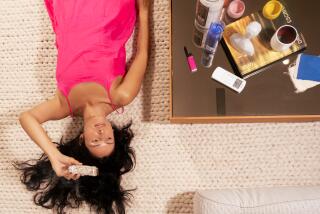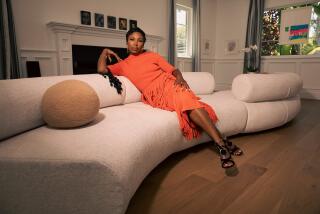Recasting the Ancient Art of Making Faces
- Share via
Who was that mask lady?
And just why has Harriet Zeitlin been appearing all over Southern California, covering faces with strips of gauze?
Gifted students, the developmentally disabled, senior citizens--you name them, all have had their countenances copied.
A cast of thousands--or rather a thousand casts, the plaster kind.
“There is no greater ego trip,” Zeitlin said in her Brentwood home, surrounded by her artistry. “I’ve never seen anyone disappointed with a duplication of how they look.”
One time, as she was concluding her presentation at the Abram Friedman Occupational Center, in walked the principal. Seeing the masks his pupils had just finished making of their own faces, he couldn’t resist: Could he also go through the procedure?
The Warrior King
“He sat down, had the gauze applied, and got up 20 minutes later holding a copy of his face,” the teacher recalled. “These masks are usually decorated afterward, and he asked me if I would do so for him. I decided to make him a warrior king. I painted the plaster black, used egg shells for eyes, yarn for hair. He loved it.”
But as with everything else in life, there are surprises for a mask expert, and not always what one would wish.
“Once, at a class for developmentally disabled students, I couldn’t pull the mask off one of them,” Zeitlin remembered. “We hadn’t applied enough of a Vaseline base on her face in the beginning. I panicked. I began thinking of the Man in the Iron Mask (the mysterious French prisoner held masked for more than 40 years in the 17th Century by Louis XIV).
“Suppose this girl had to go forever through life wearing a mask.”
The concealment eventually lifted, as did everyone’s tension. “That was during a 10-week course I did for a workshop of the Exceptional Children’s Foundation,” Zeitlin said. “It dealt with painting and printing and drawing, but the big hit was mask making. People who couldn’t speak or wouldn’t speak or didn’t speak, all wanted to make masks. It drew them out.”
Which has been true for some time now. Depictions of masks have been found in Paleolithic cave paintings in southern France, dating from as early as 30,000 years ago.
Those early attempts probably weren’t nearly as much fun as the current ones, unless you liked mud on your face.
“Our first step is to smear Vaseline all over the face, including the eyelids, eyebrows and sideburns,” Zeitlin said. (She was between presentations and described the procedure in her home.)
“Then I tie back the hair with cloth, so it won’t get in the way. This fabric also is the support to which the mask is attached at the forehead.
“I use surgical gauze, impregnated with plaster, the same kind doctors use to make casts. This I cut into strips of 2 inches, sometimes thinner.
Nostrils and Eyes
“I dip each strip into a bowl of warm water, and smooth it over the petroleum jelly. Each strip is placed side by side, although I leave openings for the nostrils and eyes, otherwise people might be frightened that it was too much like a death mask.”
All the while the subject is observing the operation in a hand-held mirror, even as others in the audience take turns applying the strips and as a second layer is put on to give the mask strength.
“The gratification of creation is almost instantaneous for everyone,” the artist said. “For the subject, there additionally is the ego fulfillment of seeing his or her facial structure and features faithfully duplicated.”
Irony of ironies, not too long ago Zeitlin found herself having a cast applied--and it involved precious little ego.
“Last spring, while I was taking a performance workshop, we were doing an exercise in which I was tied by a rope to three other people. We were twisting and relating to one another, when somebody jerked the rope, and I found myself suddenly sitting. I must have put my right hand out to break the fall.”
Fingers-to-Elbow Cast
What she broke was her wrist, and for six weeks found herself in a cast from the fingers to the elbow.
Mostly, though, when she is in a cast, it is of her own doing--as her own model.
Zeitlin is a multimedia artist (paintings, prints, sculptures, quilts and masks) who has had both solo exhibitions and been part of group exhibitions.
She was graduated from the University of Pennsylvania with a bachelor of fine arts degree, in conjunction with the Pennsylvania Academy of Fine Arts. She has had 16 solo shows here and abroad and was active in the Artists’ Rights movement of the 1970s, which tried to further the economic position of artists.
Some of her prints are in the permanent collection of the County Museum of Art, Library of Congress and the Grunwald Center for the Graphic Arts at UCLA. And numerous audiences have listened to her mask presentations in the six years since she took a course in the subject at the Craft & Folk Art Museum here.
Model of Availability
When she is in need of a head for a sculpture or to adhere to a painting, she looks no farther than her bathroom mirror.
“I use the same procedure as I would in a class, and make a mask of my own face,” she said. “You wouldn’t recognize it afterward (when decorated) as me.”
Preceding any of her paid class presentations is a slide show tracing the history and purposes of the mask.
“It was once thought of as a sacred and powerful tool to be used in talking to gods and demons. Today we use it mostly for fun on Halloween, at masquerade parties, in the theater, during parades and festivals, for protection in sports, during surgery and welding and in outer space.”
She added, however, that to this day she is still fascinated by the applause that invariably rings out after the removal of a mask at one of her presentations.
“I think we all subconsciously relate to the mask as a sacred tool to talk to the spirit world,” she said. “People feel the mystery of it.”
Everyday Masks
More than a few people put on a mask every day. “When you are putting makeup on your face, you are creating a mask,” she mused.
And don’t forget suntans. “When you get one, you are changing your appearance,” Zeitlin said. “In a sense, a suntan is a mask. So are face lifts.”
To say nothing of vacations. “Why do we go on vacation? One reason is to assume something of another identity, just as a mask allows you to live vicariously,” she went on.
The popularity of Halloween needs no elaboration. “Everyone loves to become someone else,” she said.


